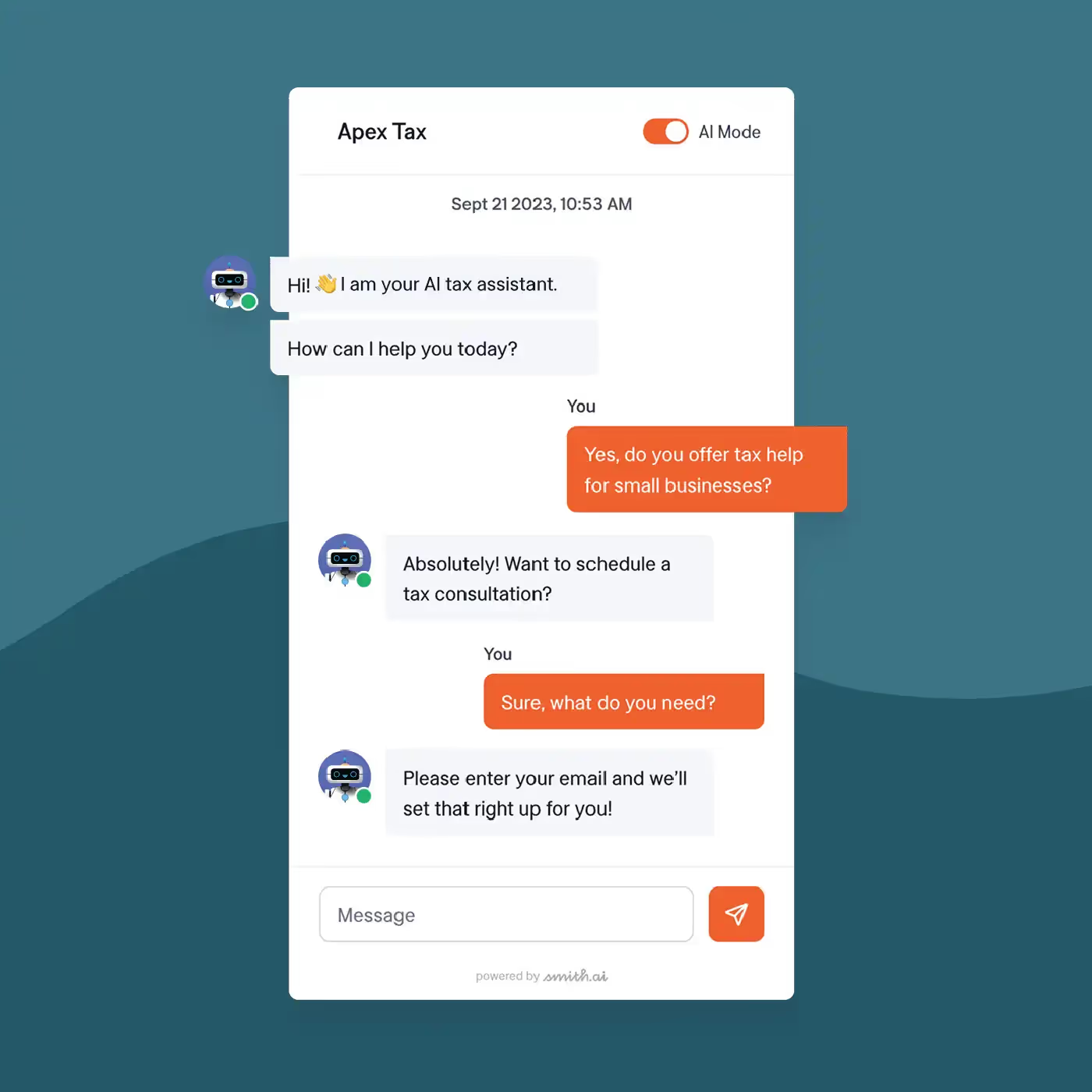AI Answering Service Costs & ROI Explained
AI Answering Service Costs & ROI Explained

Every missed call costs you money and damages customer trust. Yet many small- and midsize businesses still use phone systems that go silent after hours. Traditional live answering services try to solve this problem, but they're expensive.
Traditional answering service pricing can range quite a bit. Depending on the service provider, prices can start from $100 per month and can reach $1,000+ depending on call volume.
However, the traditional method is fading fast. Thanks to AI answering services and AI Receptionist services. These can offer huge cost savings while improving productivity all at once.
This guide breaks down the numbers — pricing structures, provider comparisons, and a step-by-step ROI model. You'll see exactly which mix of AI and human support makes sense for your business.
The AI Receptionist from Smith.ai keeps costs predictable while ensuring every caller gets the attention they deserve.
Traditional Live Answering vs. AI (and Hybrid) Services:
When prospects call your business, you have three ways to handle it: traditional live receptionists, pure AI voice assistants, or hybrid services that blend AI efficiency with human judgment. Each model hits your budget and customer experience differently.
Traditional live answering puts human agents on every call. Labor drives the cost, so bills add up fast. Common packages run $150–$700 monthly, with annual spend typically landing between $12,000 and $36,000 depending on call volume and per-minute overages. Extra needs push totals higher.
AI-led services significantly reduce labor cost. Many plans start well below $99 monthly for hundreds of included minutes, and additional usage is often billed at about $0.20–$0.30 per minute or included in subscription plans. 24/7 availability and multilingual support are standard features at no extra cost.
Hybrid services split the difference. Routine calls flow through AI while complex, high-value conversations escalate to live professionals.
Pricing Structures Explained
Understanding the variety of pricing structures for telephone reception services is essential for making informed decisions that align with your business needs. Providers offer a range of options, each with unique implications for cost predictability and budgeting. The three most common pricing models are pay-per-minute, pay-per-call, and monthly subscription or tiered bundles.
Pay-per-Minute Plans
With pay-per-minute plans, costs are measured by the total duration of calls handled. In the U.S., typical rates range from $1.15 to $1.75 per minute, whereas offshore services offer lower rates, generally between $0.65 and $0.95 per minute. Despite potential cost benefits, this model can pose challenges due to its unpredictability, with costs escalating quickly as call durations lengthen.
Pay-per-Call
This model charges a fixed rate per call, providing greater cost predictability. Smith.ai excels in this area with transparent pricing devoid of hidden fees, allowing businesses to budget with confidence. Additionally, features like spam-call blocking are included, ensuring you only pay for legitimate business interactions. This setup is particularly advantageous for small to medium-sized businesses that need consistent and predictable budgeting strategies.
Monthly Subscription / Tiered Bundles
A monthly subscription model offers a flat rate for a preset number of minutes or calls, often packaged with additional integrations or features. Typical tiers might range from $150 to $250 for 100-150 minutes, and $300 to $400 for 200-250 minutes. These plans provide predictability, but it's crucial to watch for overage fees if your call volume exceeds the limits.
For instance, Smith.ai offers AI Receptionist plans for $95.00 per month (for 50 calls). or $270 for 150 calls/month, which cater to different business scales and usage patterns.
Each pricing model suits different business call patterns and financial strategies, so it's important to match the plan to your specific needs to ensure both service efficiency and cost-effectiveness.
Provider Snapshot: Smith.ai vs. Four Other Market Leaders
Comparing call reception services requires cutting through marketing noise to find real value. This breakdown covers five market leaders with current pricing and features — verify rates directly with each provider since pricing changes frequently.
*Baseline cost reflects the lowest publicly advertised package as of the latest published data.
The providers split into two camps: Ruby and AnswerConnect use live agents with per-minute billing, while Dialbox and Convin focus on AI technology.
Smith.ai combines both approaches with pay-per-call pricing that includes AI efficiency and human backup. This hybrid model charges only for legitimate business calls — spam gets filtered before billing — and avoids penalties for longer, detailed conversations.
Integration capabilities often determine long-term value. Smith.ai's 5,000+ software connections significantly outpace competitors, reducing manual data entry and workflow disruptions. Combined with spam blocking and first-call resolution tools, total ownership costs frequently fall below traditional service prices.
ROI Calculation Framework
Before you can decide whether an AI phone receptionist makes financial sense, you need a simple, repeatable way to measure returns. This five-step framework keeps the math grounded in real business outcomes.
The foundation starts with identifying every cost involved. Capture one-time setup fees, monthly subscriptions, staff training, integrations, and ongoing support. Anything you pay because you adopted the service belongs here.
Next, add up the benefits. Most gains fall into three buckets: labor savings, incremental revenue from leads you would have missed, and productivity improvements — the hours your team wins back.
Run the numbers by plugging your totals into the standard formula: ROI = ((Total Benefits – Total Costs) / Total Costs) × 100. A positive result means the service is paying you back; the higher the percentage, the faster you're recouping your investment.
Track the right metrics with a live dashboard of call volume and percentage handled by AI, average response and resolution times, and lead-to-customer conversion rate. Monitor Customer Satisfaction (CSAT) or Net Promoter Score (NPS) alongside repeat-caller or churn rate. These data points feed directly into your benefit calculations and let you spot drift early.
Finally, revisit strategic value. Not every win shows up immediately on a balance sheet. Improved CSAT or NPS often translates into lower churn, and assigning a dollar value to retained customers reveals hidden upside. Long-term gains like stronger brand reputation or a more resilient after-hours presence also matter, even if they're harder to quantify.
Whenever you update the framework, run a quick what-if analysis: if call volume doubles, if staffing costs rise, or if customer expectations shift. That habit keeps your ROI grounded in real-world conditions and ensures your AI investment stays aligned with business goals.
Worked ROI Example (Smith.ai Numbers)
Take a five-person law firm handling about 200 inbound calls monthly. Hiring a full-time receptionist means paying $35,000–$55,000 annually before benefits and taxes. Even outsourcing to a traditional live service costs serious money: popular minute-based plans run $12,000–$36,000 annually depending on volume and extras like bilingual support.
The costs are typically monthly and depend on your plan and volume, but onboarding and integrations are included at no extra charge with your Smith.ai subscription.
The ROI calculation tells the story. Using just the labor savings to stay conservative: $45,000 in benefits minus $2,400 in costs, divided by $2,400, times 100 equals 1,775% ROI.
Even the apples-to-apples comparison against a mid-tier live plan shows strong returns. With $15,600 in savings minus $2,400 in costs, divided by $2,400, times 100, you get approximately 550% ROI.
These numbers exclude potential upside from smoother lead capture or faster follow-up, but the cost comparison alone makes a compelling case. Smith.ai filters junk calls and pipes legitimate conversations straight into your CRM, so you're not paying for spam or manual data entry (two hidden drains that erode ROI with many minute-based providers).
When you combine predictable per-call pricing with dramatic labor savings and built-in efficiency gains, the AI Receptionist from Smith.ai turns a fixed operational cost into a high-return investment almost immediately.
Turn Your Phone System Into a Profit Center, Not a Cost Center
Transparent pricing models matter as much as total costs. Pay-per-call plans eliminate minute-by-minute uncertainty, and hybrid AI-plus-human systems deliver predictable expenses without sacrificing the personal touch complex calls require. The AI Receptionist from Smith.ai exemplifies this approach: clear per-call rates, automatic spam blocking, and numerous pre-built integrations that work with your existing systems instead of creating new complications.
See the impact on your specific situation by reaching out for a free consultation — we'll calculate the ROI using your actual call volume and business metrics. For a lower-commitment start, try a small bundle and track response times, lead conversions, and customer satisfaction for 30 days. The data will demonstrate the value, and you can expand once the returns are proven.
Take the faster path to growth. Get Smith.ai today.
Key Areas to Explore
Technical Implementation Terms
Voice user interface (VUl) design
Speech recognition integration
Text-to-speech optimization
API connectivity and webhooks
Real-time data synchronization

Your submission has been received!










.svg)



